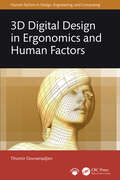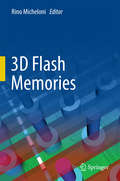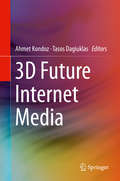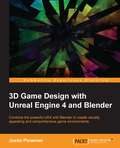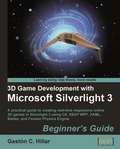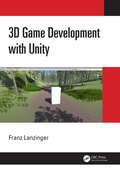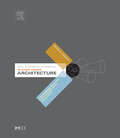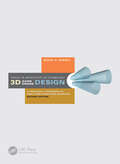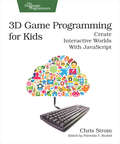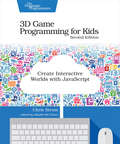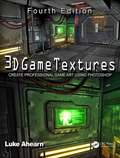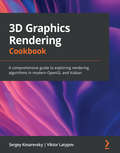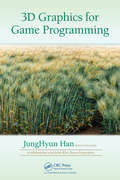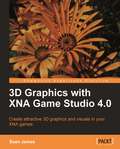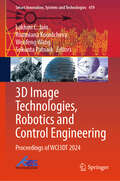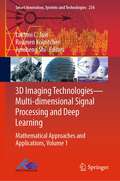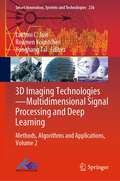- Table View
- List View
3D Data Science with Python: Building Accurate Digital Environments with 3D Point Cloud Workflows
by Florent PouxOur physical world is grounded in three dimensions. To create technology that can reason about and interact with it, our data must be 3D too. This practical guide offers data scientists, engineers, and researchers a hands-on approach to working with 3D data using Python. From 3D reconstruction to 3D deep learning techniques, you'll learn how to extract valuable insights from massive datasets, including point clouds, voxels, 3D CAD models, meshes, images, and more.Dr. Florent Poux helps you leverage the potential of cutting-edge algorithms and spatial AI models to develop production-ready systems with a focus on automation. You'll get the 3D data science knowledge and code to:Understand core concepts and representations of 3D dataLoad, manipulate, analyze, and visualize 3D data using powerful Python librariesApply advanced AI algorithms for 3D pattern recognition (supervised and unsupervised)Use 3D reconstruction techniques to generate 3D datasetsImplement automated 3D modeling and generative AI workflowsExplore practical applications in areas like computer vision/graphics, geospatial intelligence, scientific computing, robotics, and autonomous drivingBuild accurate digital environments that spatial AI solutions can leverageFlorent Poux is an esteemed authority in the field of 3D data science who teaches and conducts research for top European universities. He's also head professor at the 3D Geodata Academy and innovation director for French Tech 120 companies.
3D Deep Learning with Python: Design and develop your computer vision model with 3D data using PyTorch3D and more
by Xudong Ma Vishakh Hegde Lilit YolyanVisualize and build deep learning models with 3D data using PyTorch3D and other Python frameworks to conquer real-world application challenges with easeKey FeaturesUnderstand 3D data processing with rendering, PyTorch optimization, and heterogeneous batchingImplement differentiable rendering concepts with practical examplesDiscover how you can ease your work with the latest 3D deep learning techniques using PyTorch3DBook DescriptionWith this hands-on guide to 3D deep learning, developers working with 3D computer vision will be able to put their knowledge to work and get up and running in no time.Complete with step-by-step explanations of essential concepts and practical examples, this book lets you explore and gain a thorough understanding of state-of-the-art 3D deep learning. You'll see how to use PyTorch3D for basic 3D mesh and point cloud data processing, including loading and saving ply and obj files, projecting 3D points into camera coordination using perspective camera models or orthographic camera models, rendering point clouds and meshes to images, and much more. As you implement some of the latest 3D deep learning algorithms, such as differential rendering, Nerf, synsin, and mesh RCNN, you'll realize how coding for these deep learning models becomes easier using the PyTorch3D library.By the end of this deep learning book, you'll be ready to implement your own 3D deep learning models confidently.What you will learnDevelop 3D computer vision models for interacting with the environmentGet to grips with 3D data handling with point clouds, meshes, ply, and obj file formatWork with 3D geometry, camera models, and coordination and convert between themUnderstand concepts of rendering, shading, and more with easeImplement differential rendering for many 3D deep learning modelsAdvanced state-of-the-art 3D deep learning models like Nerf, synsin, mesh RCNNWho this book is forThis book is for beginner to intermediate-level machine learning practitioners, data scientists, ML engineers, and DL engineers who are looking to become well-versed with computer vision techniques using 3D data.
3D Digital Design in Ergonomics and Human Factors (Human Factors in Design, Engineering, and Computing)
by Tihomir Dovramadjiev3D Digital Design in Ergonomics and Human Factors is the definitive guide to understanding how 3D software impacts the practice of ergonomics and human factors and how it can be utilized successfully in a variety of different settings. It covers interdisciplinary areas, including ergonomics and human factors, 3D digital design, sustainable digital human anatomical design through Open-Source Software (OSS), and advanced technologies in design. It helps readers at any skill level in 2D and 3D design to increase their competency in this ever-growing field of study. Written in an inclusive, jargon-free way, the book covers the significance of 3D digital design for ergonomics and human factors. It includes an explanation of the structural features of 3D polygonal-mesh modeling and 3D solid modeling (Computer Aided Design—CAD). Within digital OSS, the modeling of anatomical digital humans, integration of AI tools, and advancements in ergonomics, MoCap, and bioengineering for inclusive healthcare are presented in detail. Technologically effective digital OSSs are featured with which the modeling of anatomical digital human, the development of ergonomics and motion capture (MoCap), and ergonomics and bioengineering for inclusive healthcare are possible. Direct useful links to OSS 2D and 3D software and add-ons for expanding the capabilities of digital modelling are presented, and file formats and their extensions receive significant coverage.This modern and timely book will appeal to students, academics, scientists, and professionals associated with 3D digital design, ergonomics and human factors, digital human modeling, bioengineering, healthcare, information technology, workplace safety, education, and proponents of OSS for 2D and 3D design. It provides readers with the necessary digital tools for their activities and needs by giving real, successful examples from practice.
3D Engine Design for Virtual Globes
by Patrick Cozzi Kevin RingSupported with code examples and the authors’ real-world experience, this book offers the first guide to engine design and rendering algorithms for virtual globe applications like Google Earth and NASA World Wind. The content is also useful for general graphics and games, especially planet and massive-world engines. With pragmatic advice throughout, it is essential reading for practitioners, researchers, and hobbyists in these areas, and can be used as a text for a special topics course in computer graphics. Topics covered include: Rendering globes, planet-sized terrain, and vector data; Multithread resource management; Out-of-core algorithms; Shader-based renderer design.
3D Engine Design for Virtual Globes
by Patrick Cozzi Kevin RingSupported with code examples and the authors' real-world experience, this book offers the first guide to engine design and rendering algorithms for virtual globe applications like Google Earth and NASA World Wind. The content is also useful for general graphics and games, especially planet and massive-world engines. With pragmatic advice throughout
3D Environment Design with Blender: Enhance your modeling, texturing, and lighting skills to create realistic 3D scenes
by Abdelilah Hamdani Carlos BarretoSave time and effort when building 3D scenes with this essential guide to creating stunning photorealistic 3D environments in BlenderKey FeaturesReveal modeling tricks to make your Blender 3D environments look realisticDiscover techniques to enhance the photorealism of your scenes while saving timeSet up realistic lighting in your scenes to make your environment look pleasing to the eyeBook DescriptionBlender is a powerful tool for creating all kinds of visual assets, but with such power comes complexity. Creating a photorealistic 3D scene seems like a Herculean task for more than 90% of 3D designers, but don't be discouraged! 3D Environment Design with Blender will get you up and running.This practical guide helps reduce the complexity of 3D environment design, advance your Blender skills, and produce lifelike scenes and animations in a time-efficient manner. You'll start by learning how to fix the most common mistakes 3D designers make with modeling and scale matching that stop them from achieving photorealism. Next, you'll understand the basics of realistic texturing, efficient unwrapping and achieving photorealistic lighting by turning an actual reference of a wood cabin into a realistic 3D scene. These skills will be used and expanded as you build a realistic 3D environment with natural assets and materials that you'll create from scratch. Once you've developed your natural environment, you'll advance to creating realistic render shots by applying cool camera features, and compositing tricks that will make your final render look photorealistic and pleasing to the eye.By the end of this book, you'll be able to implement modeling tricks and best practices to make your 3D environments look stunningly lifelike.What you will learnUnderstand how to avoid the most common modeling mistakes 3D designers makeCreate realistic landscapes using Blender's built-in A.N.T Landscape add-onBuild natural assets such as rocks, flowers, plants, and rivers that you can customize and use in a variety of projectsCreate realistic materials such as snow, mud, wood and animated waterUse the particle system to generate realistic grass, as well as scatter flowers and rocksApply the five lighting rules to achieve great photorealistic resultsUse nodes and materials effectively to produce impressive resultsWho this book is forThis book is for 3D environment artists and open-world game designers who have tried designing 3D environments but have trouble finding the right Blender settings. If you feel overwhelmed understanding how nodes and materials work in Blender, this book will simplify it for you and help you achieve photorealism in your environments in no time. Familiarity with the Blender interface is expected to get the most out of this book.
3D Environment Design with Blender: Enhance your modeling, texturing, and lighting skills to create realistic 3D scenes
by Abdelilah HamdaniSave time and effort when building 3D scenes with this essential guide to creating stunning photorealistic 3D environments in BlenderKey FeaturesReveal modeling tricks to make your Blender 3D environments look realisticDiscover techniques to enhance the photorealism of your scenes while saving timeSet up realistic lighting in your scenes to make your environment look pleasing to the eyeBook DescriptionBlender is a powerful tool for creating all kinds of visual assets, but with such power comes complexity. Creating a photorealistic 3D scene seems like a Herculean task for more than 90% of 3D designers, but don’t be discouraged! 3D Environment Design with Blender will get you up and running. This practical guide helps reduce the complexity of 3D environment design, advance your Blender skills, and produce lifelike scenes and animations in a time-efficient manner. You'll start by learning how to fix the most common mistakes 3D designers make with modeling and scale matching that stop them from achieving photorealism. Next, you’ll understand the basics of realistic texturing, efficient unwrapping and achieving photorealistic lighting by turning an actual reference of a wood cabin into a realistic 3D scene. These skills will be used and expanded as you build a realistic 3D environment with natural assets and materials that you’ll create from scratch. Once you’ve developed your natural environment, you’ll advance to creating realistic render shots by applying cool camera features, and compositing tricks that will make your final render look photorealistic and pleasing to the eye. By the end of this book, you'll be able to implement modeling tricks and best practices to make your 3D environments look stunningly lifelike.What you will learnUnderstand how to avoid the most common modeling mistakes 3D designers makeCreate realistic landscapes using Blender s built-in A.N.T Landscape add-onBuild natural assets such as rocks, flowers, plants, and rivers that you can customize and use in a variety of projectsCreate realistic materials such as snow, mud, wood and animated waterUse the particle system to generate realistic grass, as well as scatter flowers and rocksApply the five lighting rules to achieve great photorealistic resultsUse nodes and materials effectively to produce impressive resultsWho this book is forThis book is for 3D environment artists and open-world game designers who have tried designing 3D environments but have trouble finding the right Blender settings. If you feel overwhelmed understanding how nodes and materials work in Blender, this book will simplify it for you and help you achieve photorealism in your environments in no time. Familiarity with the Blender interface is expected to get the most out of this book.
3D Flash Memories
by Rino MicheloniThis book walks the reader through the next step in the evolution of NAND flash memory technology, namely the development of 3D flash memories, in which multiple layers of memory cells are grown within the same piece of silicon. It describes their working principles, device architectures, fabrication techniques and practical implementations, and highlights why 3D flash is a brand new technology. After reviewing market trends for both NAND and solid state drives (SSDs), the book digs into the details of the flash memory cell itself, covering both floating gate and emerging charge trap technologies. There is a plethora of different materials and vertical integration schemes out there. New memory cells, new materials, new architectures (3D Stacked, BiCS and P-BiCS, 3D FG, 3D VG, 3D advanced architectures); basically, each NAND manufacturer has its own solution. Chapter 3 to chapter 7 offer a broad overview of how 3D can materialize. The 3D wave is impacting emerging memories as well and chapter 8 covers 3D RRAM (resistive RAM) crosspoint arrays. Visualizing 3D structures can be a challenge for the human brain: this is way all these chapters contain a lot of bird's-eye views and cross sections along the 3 axes. The second part of the book is devoted to other important aspects, such as advanced packaging technology (i. e. TSV in chapter 9) and error correction codes, which have been leveraged to improve flash reliability for decades. Chapter 10 describes the evolution from legacy BCH to the most recent LDPC codes, while chapter 11 deals with some of the most recent advancements in the ECC field. Last but not least, chapter 12 looks at 3D flash memories from a system perspective. Is 14nm the last step for planar cells? Can 100 layers be integrated within the same piece of silicon? Is 4 bit/cell possible with 3D? Will 3D be reliable enough for enterprise and datacenter applications? These are some of the questions that this book helps answering by providing insights into 3D flash memory design, process technology and applications.
3D Future Internet Media
by Ahmet Kondoz Tasos DagiuklasThis book describes recent innovations in 3D media and technologies, with coverage of 3D media capturing, processing, encoding, and adaptation, networking aspects for 3D Media, and quality of user experience (QoE). The main contributions are based on the results of the FP7 European Projects ROMEO, which focus on new methods for the compression and delivery of 3D multi-view video and spatial audio, as well as the optimization of networking and compression jointly across the Future Internet (www. ict-romeo. eu). The delivery of 3D media to individual users remains a highly challenging problem due to the large amount of data involved, diverse network characteristics and user terminal requirements, as well as the user's context such as their preferences and location. As the number of visual views increases, current systems will struggle to meet the demanding requirements in terms of delivery of constant video quality to both fixed and mobile users. ROMEO will design and develop hybrid-networking solutions that combine the DVB-T2 and DVB-NGH broadcast access network technologies together with a QoE aware Peer-to-Peer (P2P) distribution system that operates over wired and wireless links. Live streaming 3D media needs to be received by collaborating users at the same time or with imperceptible delay to enable them to watch together while exchanging comments as if they were all in the same location. The volume provides state-of-the-art information on 3D multi-view video, spatial audio networking protocols for 3D media, P2P 3D media streaming, and 3D Media delivery across heterogeneous wireless networks among other topics. Graduate students and professionals in electrical engineering and computer science with an interest in 3D Future Internet Media will find this volume to be essential reading.
3D Game Design with Unreal Engine 4 and Blender
by Justin PlowmanCombine the powerful UE4 with Blender to create visually appealing and comprehensive game environments About This Book * The only resource that shows how you can incorporate Blender into your Unreal Engine 4 Game environment * Create amazing 3D game environments by leveraging the power of Blender and Unreal Engine 4 * Practical step-by-step approach with plenty of illustrative examples to get you started immediately Who This Book Is For This book would be ideal for 3D artists and game designers who want to create amazing 3D game environments and leverage the power of Blender with Unreal Engine 4. 3D design basics would be necessary to get the most out of this book. Some previous experience with Blender would be helpful but not essential What You Will Learn * Create a fully functioning game level of your own design using Blender and Unreal Engine 4 * Customize your level with detailed 3D assets created with Blender * Import assets into Unreal Engine 4 to create an amazing finished product * Build a detailed dynamic environment with goals and an ending * Explore Blender's incredible animation tools to animate elements of your game * Create great environments using sound effects, particle effects, and class blueprints In Detail Unreal Engine 4 now has support for Blender, which was not available in earlier versions. This has opened up new possibilities and that is where this book comes in. This is the first book in the market combining these two powerful game and graphic engines. Readers will build an amazing high-level game environment with UE4 and will show them how to use the power of Blender 3D to create stunning animations and 3D effects for their game. This book will start with creating levels, 3D assets for the game, game progression, light and environment control, animation, and so on. Then it will teach readers to add amazing visual effects to their game by applying rendering, lighting, rigging, and compositing techniques in Blender. Finally, readers will learn how to smoothly transfer blender files to UE4 and animate the game assets. Each chapter will add complexities to the game environment. Style and approach This will have a clear, step-by-step approach to creating game assets in Blender and then importing them to UE4 to create stunning game environments. All asset creation techniques are explained in detail along with tips on how to use them to create your own game environments. The book offers end-to-end coverage of how to design a game level from scratch.
3D Game Development with Microsoft Silverlight 3: Beginner's Guide
by Gaston C. HillarThis book takes a step-by-step approach to building a complete interactive 3D game using Silverlight and enhancing it through its related technologies. The book focuses on practical examples and has a friendly approach, with the opportunity to learn by experiment and play. It uses illustrations, screenshots, and interactive experiences to understand the most complex topics related to the 3D scenes. This book is designed primarily for C# developers with basic knowledge of the Visual Studio IDE who want to develop online 3D games using Silverlight or create interactive 3D scenes for a web site with animated models. No prior experience in 3D programming, 3D animation, or Silverlight is required. The book is also aimed at 3D developers who want to improve their online content, offering innovative 3D models in action.
3D Game Development with Unity
by Franz LanzingerThis book teaches beginners and aspiring game developers how to develop 3D games with Unity. Thousands of commercial games have been built with Unity. This book combines a practical, step-by-step approach with explanations of the underlying theory that are reinforced with hundreds of screenshots and several larger projects. Building on the knowledge developed in 2D Game Development for Unity, this book uses the Blender software for 3D modelling and texturing, GIMP for 2D art, Audacity for sound effects, and MuseScore for music composition and notation. Readers can follow the step-by-step guides and create an introductory racing game, a 3D maze game, and a 3D FPS adventure game as they progress through the chapters. The book contains numerous color illustrations and online access to easily downloadable game assets, code, and project files. Written to be accessible and easy to follow, this book will be a valuable resource to both beginner and aspiring game developers that want to develop 3D games with Unity. Franz Lanzinger is an independent game developer, author, and pianist. He is the owner of Lanzinger Studio located in Sunnyvale, California. His game development career spans almost 40 years starting with the coin-op classic Crystal Castles at Atari in 1983, continuing with Ms. Pacman and Toobin' for the NES, published by Tengen in 1990. Franz has been an indie game developer since 1991. He worked on SNES Rampart, Championship Pool, and NCAA Final Four Basketball, as well as Gubble for the PC, Mac, and PlayStation. This is Franz's third book about game development. He is currently working on a remaster of Gubble. In his spare time, he is the piano accompanist for the Valley Chorale and the Serendipity Choir. Go to franzlanzinger.com for the latest news about Franz as well as resources for his books.
3D Game Engine Architecture: Engineering Real-Time Applications with Wild Magic
by David EberlyDave Eberly's 3D Game Engine Design was the first professional guide to the essential concepts and algorithms of real-time 3D engines and quickly became a classic of game development. Dave's new book 3D Game Engine Architecture continues the tradition with a comprehensive look at the software engineering and programming of 3D engines. This book is
3D Game Engine Design: A Practical Approach to Real-Time Computer Graphics
by David EberlyThe first edition of 3D Game Engine Design was an international bestseller that sold over 17,000 copies and became an industry standard. In the six years since that book was published, graphics hardware has evolved enormously. Hardware can now be directly controlled through techniques such as shader programming, which requires an entirely new thought process of a programmer.In a way that no other book can do, this new edition shows step by step how to make a shader-based graphics engine and how to tame this new technology. Much new material has been added, including more than twice the coverage of the essential techniques of scene graph management, as well as new methods for managing memory usage in the new generation of game consoles and portable game players. There are expanded discussions of collision detection, collision avoidance, and physics—all challenging subjects for developers. The mathematics coverage is now focused towards the end of the book to separate it from the general discussion.As with the first edition, one of the most valuable features of this book is the inclusion of Wild Magic, a commercial quality game engine in source code that illustrates how to build a real-time rendering system from the lowest-level details all the way to a working game. Wild Magic Version 4 consists of over 300,000 lines of code that allows the results of programming experiments to be seen immediately. This new version of the engine is fully shader-based, runs on Windows XP, Mac OS X, and Linux, and is only available with the purchase of the book.
3D Game Environments: Create Professional 3D Game Worlds
by Luke AhearnFrom a steamy jungle to a modern city, or even a sci-fi space station, 3D Game Environments is the ultimate resource to help you create AAA quality art for a variety of game worlds. Primarily using Photoshop and 3ds Max, students will learn to create realistic textures from photo source and a variety of techniques to portray dynamic and believable game worlds. With detailed tutorials on creating 3D models, applying 2D art to 3D models, and clear concise advice on issues of efficiency and optimization for a 3D game engine, Luke Ahearn gives you everything students need to make their own realistic game environments.
3D Game Programming for Kids: Create Interactive Worlds with JavaScript
by Chris StromPrinted in full color.You know what's even better than playing games? Creating your own. Even if you're an absolute beginner, this book will teach you how to make your own online games with interactive examples. You'll learn programming using nothing more than a browser, and see cool, 3D results as you type. You'll learn real-world programming skills in a real programming language: JavaScript, the language of the web. You'll be amazed at what you can do as you build interactive worlds and fun games.You'll jump right in and write games and simulations while learning programming fundamentals. You'll use the ICE Code Editor, which was created especially for this book to make it easy for you to get started with JavaScript programming. With the ICE Editor, you'll see the results of your work right away. Want a red donut? You can make hundreds of them, spinning around like crazy right next to the code you just typed.You'll do hands-on coding in every chapter. You'll start by building simple animated shapes, then make your own player--who can do cartwheels! You'll learn how to build your own games from start to finish, including a monster eating fruit, a cave puzzle, and rafting on a river. You'll animate simple shapes to create a model of the solar system, and make your own website so that you can show off your games with your friends. If you just want to make games, jump to the lessons focusing on projects. To understand some of the theory better or if you need some help with functions, turn to the chapters that explain the programming concepts. We'll walk you carefully through all the math needed to bring games to life.Best of all, you get to create awesome games and say, "I made this!"
3D Game Programming for Kids: Create Interactive Worlds with JavaScript
by Chris StromYou know what's even better than playing games? Programming your own! Make your own online games, even if you're an absolute beginner. Let your imagination come to 3D life as you learn real-world programming skills with the JavaScript programming language - the language used everywhere on the web. This new edition is completely revised, and takes advantage of new programming features to make game programming even easier to learn. Plus, new effects make your games even cooler. When you're done, you're going to be amazed at what you can create. Jump right in! Start programming cool stuff on page 1. Keep building new and different things until the very last page. This book wants you to play. Not just play games, but play with code. Play with programming. Because the best way to learn something is to have fun with it! This second edition is updated from start to finish to make it even easier to get started programming in JavaScript. Every example has been updated to make it easier, with new example games to explore and new 3D effects that make your games even more fun! Want a red donut? You can make hundreds of them, spinning around like mad. Want to create a star field? Make a hundred or a thousand stars. Make them red, green, or blue. Explosions? Fireworks? Planets? It's up to you. And, using a code editor created especially for this book, you'll program right in your web browser. You'll see the results of your work and imagination right away - right next to the code that you just typed! Along the way, you'll pick up a ton of programming knowledge, and dive in even deeper with some more advanced chapters. Whatever you want to do, this book has your back. Best of all, you get to create awesome games and say, "I made this!" What You Need: You need the latest version of the Google Chrome Web browser, available for free from https://chrome.google.com. You also need an Internet connection to access the ICE Code Editor the first time. ICE Code Editor will be loaded onto your computer, so you won't need Internet access for later projects.
3D Game Textures: Create Professional Game Art Using Photoshop
by Luke AhearnThe new edition of 3D Game Textures: Create Professional Game Art Using Photoshop features the most up-to-date techniques that allow you to create your own unique textures, shaders, and materials. Revised to take new technology into account, it is an ideal hands-on resource for creating online worlds, simulations, web-based applications, and architectural visualization projects. Continuing the practical, no-nonsense approach of its predecessors, the fourth edition shows you how to advance your digital art skills with textures and shaders by exploring their interactions in single objects or entire scenes. It contains expanded coverage of shader nodes, and the companion website—www.lukeahearn.com/textures—has been updated to include video tutorials as well as updated sample textures, shaders, materials, actions, brushes, and all of the art from the book.
3D Graphics Rendering Cookbook: A comprehensive guide to exploring rendering algorithms in modern OpenGL and Vulkan
by Viktor Latypov Sergey KosarevskyBuild a 3D rendering engine from scratch while solving problems in a step-by-step way with the help of useful recipesKey FeaturesLearn to integrate modern rendering techniques into a single performant 3D rendering engineLeverage Vulkan to render 3D content, use AZDO in OpenGL applications, and understand modern real-time rendering methodsImplement a physically based rendering pipeline from scratch in Vulkan and OpenGLBook DescriptionOpenGL is a popular cross-language, cross-platform application programming interface (API) used for rendering 2D and 3D graphics, while Vulkan is a low-overhead, cross-platform 3D graphics API that targets high-performance applications. 3D Graphics Rendering Cookbook helps you learn about modern graphics rendering algorithms and techniques using C++ programming along with OpenGL and Vulkan APIs.The book begins by setting up a development environment and takes you through the steps involved in building a 3D rendering engine with the help of basic, yet self-contained, recipes. Each recipe will enable you to incrementally add features to your codebase and show you how to integrate different 3D rendering techniques and algorithms into one large project. You'll also get to grips with core techniques such as physically based rendering, image-based rendering, and CPU/GPU geometry culling, to name a few. As you advance, you'll explore common techniques and solutions that will help you to work with large datasets for 2D and 3D rendering. Finally, you'll discover how to apply optimization techniques to build performant and feature-rich graphics applications.By the end of this 3D rendering book, you'll have gained an improved understanding of best practices used in modern graphics APIs and be able to create fast and versatile 3D rendering frameworks.What you will learnImprove the performance of legacy OpenGL applicationsManage a substantial amount of content in real-time 3D rendering enginesDiscover how to debug and profile graphics applicationsUnderstand how to use the Approaching Zero Driver Overhead (AZDO) philosophy in OpenGLIntegrate various rendering techniques into a single applicationFind out how to develop Vulkan applicationsImplement a physically based rendering pipeline from scratchIntegrate a physics library with your rendering engineWho this book is forThis book is for 3D graphics developers who are familiar with the mathematical fundamentals of 3D rendering and want to gain expertise in writing fast rendering engines with advanced techniques using C++ libraries and APIs. A solid understanding of C++ and basic linear algebra, as well as experience in creating custom 3D applications without using premade rendering engines is required.
3D Graphics for Game Programming
by JungHyun HanDesigned for advanced undergraduate and beginning graduate courses, 3D Graphics for Game Programming presents must-know information for success in interactive graphics. Assuming a minimal prerequisite understanding of vectors and matrices, it also provides sufficient mathematical background for game developers to combine their previous experie
3D Graphics with XNA Game Studio 4.0
by Sean JamesThis book is designed as a step-by-step tutorial that can be read through from beginning to end, with each chapter building on the last. Each section, however, can also be used as a reference for implementing various camera models, special effects, etc. The chapters are filled with illustrations, screenshots, and example code, and each chapter is based around the creation of one or more example projects. By the end of the first chapter you will have created the framework that is used and improved upon for the rest of the book, and by the end of the book you will have implemented dozens of special effects, camera types, lighting models and more using that framework. This book is mainly written for those who are familiar with object oriented programming and C# and who are interested in taking 3D graphics of their XNA games to the next level. This book will be useful as learning material for those who are new to graphics and for those who are looking to expand their toolset. Also, it can be used by game developers looking for an implementation guide or reference for effects or techniques they are already familiar with.
3D Image Technologies, Robotics and Control Engineering: Proceedings of WCI3DT 2024 (Smart Innovation, Systems and Technologies #419)
by Lakhmi C. Jain Srikanta Patnaik Wenfeng Wang Roumiana KountchevaThis book features a collection of high-quality, peer-reviewed research papers presented at Third 'World Conference on Intelligent and 3D Technologies' (WCI3DT 2024), held in China during May 24–26, 2024. The book provides an opportunity to researchers and academia as well as practitioners from industry to publish their ideas and recent research development work on all aspects of 3D imaging technologies and artificial intelligence, their applications and other related areas. The book presents ideas and the works of scientists, engineers, educators and students from all over the world from institutions and industries.
3D Imaging Technologies and Deep Learning: Proceedings of the 3DIT-MSP&DL 2024 (Smart Innovation, Systems and Technologies #120)
by Lakhmi C. Jain Srikanta Patnaik Roumiana KountchevaThis book presents high-quality research in the field of 3D imaging technology. The sixth edition of International Conference on 3D Imaging Technology (3DDIT-MSP&DL 2024) continues the good traditions already established by the first five editions of the conference to provide a wide scientific forum for researchers, academia, and practitioners to exchange newest ideas and recent achievements in all aspects of image processing and analysis, together with their contemporary applications. The conference proceedings are published in two volumes. The main topics of the papers comprise famous trends as: 3D image representation, 3D image technology, 3D images and graphics, and computing and 3D information technology. In these proceedings, special attention is paid at the 3D tensor image representation, the 3D content generation technologies, big data analysis, and deep learning, artificial intelligence, the 3D image analysis and video understanding, the 3D virtual and augmented reality, and many related areas. The first volume contains papers in 3D image processing, transforms, and technologies. The second volume is about computing and information technologies, computer images and graphics and related applications. The two volumes of the book cover a wide area of the aspects of the contemporary multidimensional imaging and the related future trends from data acquisition to real-world applications based on various techniques and theoretical approaches.
3D Imaging Technologies—Multi-dimensional Signal Processing and Deep Learning: Mathematical Approaches and Applications, Volume 1 (Smart Innovation, Systems and Technologies #234)
by Lakhmi C. Jain Roumen Kountchev Junsheng ShiThis book presents high-quality research in the field of 3D imaging technology. The second edition of International Conference on 3D Imaging Technology (3DDIT-MSP&DL) continues the good traditions already established by the first 3DIT conference (IC3DIT2019) to provide a wide scientific forum for researchers, academia and practitioners to exchange newest ideas and recent achievements in all aspects of image processing and analysis, together with their contemporary applications. The conference proceedings are published in 2 volumes. The main topics of the papers comprise famous trends as: 3D image representation, 3D image technology, 3D images and graphics, and computing and 3D information technology. In these proceedings, special attention is paid at the 3D tensor image representation, the 3D content generation technologies, big data analysis, and also deep learning, artificial intelligence, the 3D image analysis and video understanding, the 3D virtual and augmented reality, and many related areas. The first volume contains papers in 3D image processing, transforms and technologies. The second volume is about computing and information technologies, computer images and graphics and related applications. The two volumes of the book cover a wide area of the aspects of the contemporary multidimensional imaging and the related future trends from data acquisition to real-world applications based on various techniques and theoretical approaches.
3D Imaging Technologies—Multidimensional Signal Processing and Deep Learning: Methods, Algorithms and Applications, Volume 2 (Smart Innovation, Systems and Technologies #236)
by Lakhmi C. Jain Roumen Kountchev Yonghang TaiThis book presents high-quality research in the field of 3D imaging technology. The second edition of International Conference on 3D Imaging Technology (3DDIT-MSP&DL) continues the good traditions already established by the first 3DIT conference (IC3DIT2019) to provide a wide scientific forum for researchers, academia and practitioners to exchange newest ideas and recent achievements in all aspects of image processing and analysis, together with their contemporary applications. The conference proceedings are published in 2 volumes. The main topics of the papers comprise famous trends as: 3D image representation, 3D image technology, 3D images and graphics, and computing and 3D information technology. In these proceedings, special attention is paid at the 3D tensor image representation, the 3D content generation technologies, big data analysis, and also deep learning, artificial intelligence, the 3D image analysis and video understanding, the 3D virtual and augmented reality, and many related areas. The first volume contains papers in 3D image processing, transforms and technologies. The second volume is about computing and information technologies, computer images and graphics and related applications. The two volumes of the book cover a wide area of the aspects of the contemporary multidimensional imaging and the related future trends from data acquisition to real-world applications based on various techniques and theoretical approaches.


